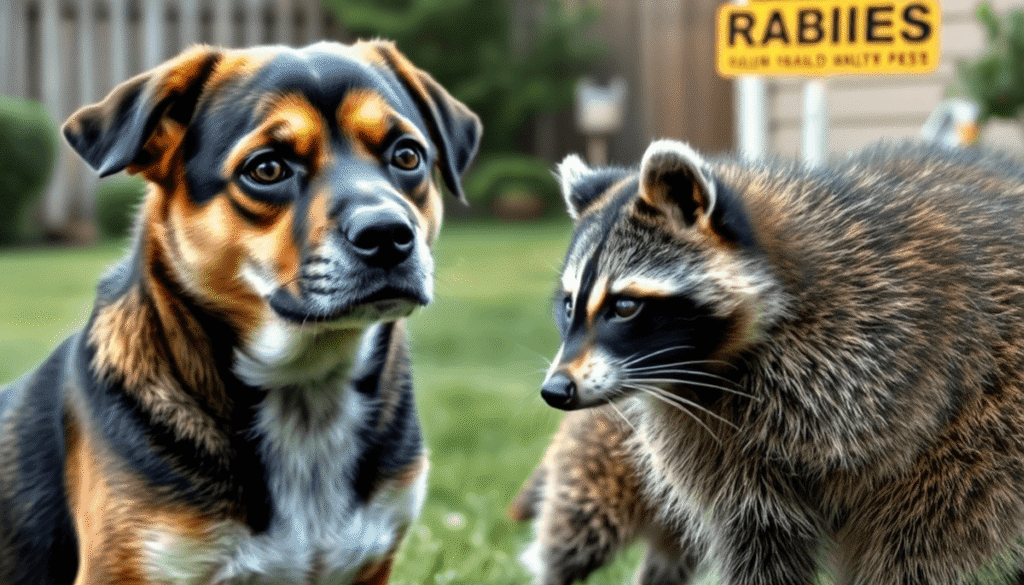How to Spot the Early Signs of Rabies in Animals
Rabies is one of the deadliest viral diseases that can affect both animals and humans. This disease, which is transmitted from animals to humans, attacks the nervous system with deadly precision, leading to almost certain death once symptoms appear.
The virus hides in infected animals and spreads through contact with saliva, usually through bites or scratches. What makes rabies particularly dangerous is its ability to infect any mammal, including our beloved pets and wild animals that may be in our neighborhoods.
Early detection can mean the difference between life and death. Recognizing the initial signs of rabies in animals is crucial in defending against this deadly disease. These warning signs may initially seem subtle:
- Unexpected changes in behavior
- Unusual aggression or extreme calmness
- Alterations in eating habits
- Strange sounds or vocalizations
By learning to recognize these early signs, you empower yourself to protect your loved ones, pets, and community. Swift identification enables prompt medical treatment and helps prevent the virus from spreading to other animals or humans.
Understanding Rabies in Animals
Rabies is a deadly viral infection that specifically targets the central nervous system of mammals. The virus belongs to the Lyssavirus genus and infiltrates the brain tissue, causing severe inflammation that disrupts normal neurological functions.
The transmission of rabies occurs through direct contact with infected bodily fluids, primarily saliva. Here’s how the virus typically spreads:
- Bite transmission: The most common method, where an infected animal’s saliva enters the bloodstream through a bite wound
- Scratch infections: Deep scratches from infected animals can transmit the virus if saliva is present
- Mucous membrane exposure: The virus can enter through contact with eyes, nose, or mouth
- Open wound contact: Fresh cuts or abrasions exposed to infected saliva
Wild animals serve as natural reservoirs for the rabies virus:
- Bats
- Raccoons
- Foxes
- Skunks
- Coyotes
The virus travels from the infection site through the peripheral nerves, making its way to the brain. This journey can take anywhere from several days to months, depending on:
- Distance between bite location and brain
- Amount of virus transmitted
- Strength of the host’s immune system
- Type of rabies variant
Understanding these transmission patterns helps explain why immediate medical attention is essential after potential exposure to a rabid animal.
Stages of Rabies Progression
Rabies has three main stages, each with its own symptoms that show how the disease is progressing. Knowing these stages can help us recognize infected animals at different times in the illness.
1. Prodromal Stage
- Duration: 2-3 days
- Subtle personality changes
- Fever and loss of appetite
- Mild anxiety or restlessness
- Licking or chewing at bite site
- Animals may seek solitude
- Domestic pets show unusual affection
2. Furious Stage
- Duration: 1-7 days
- Extreme aggression
- Attacks on people, animals, objects
- Constant pacing and restlessness
- Muscle spasms and seizures
- Excessive drooling
- Heightened sensitivity to light and sound
- Loss of fear toward natural predators
3. Paralytic Stage
- Duration: 2-4 days
- Progressive paralysis starting at bite location
- Difficulty swallowing
- Foaming at mouth
- Dropping jaw
- Inability to control facial muscles
- Labored breathing
- Coma
Each animal may not show every symptom, and some might skip certain stages completely. Wild animals usually show stronger symptoms during the furious stage, while domestic animals often move quickly to the paralytic stage. The time between stages can vary among different species and individuals, so it’s important to keep a close eye on them for an accurate diagnosis.
The virus affects different parts of the brain during each stage, causing specific changes in behavior and physical abilities. In the prodromal stage, the virus attacks the limbic system; in the furious stage, it affects the aggression centers; and in the paralytic stage, it impacts the brain stem and motor neurons.
Common Early Signs of Rabies in Animals
Recognizing early signs of rabies can mean the difference between life and death. Animals infected with rabies display distinct behavioral changes that serve as crucial warning signals:
Sudden Behavioral Changes
- Unprovoked aggression toward humans and other animals
- Excessive irritability and restlessness
- Loss of fear toward humans
- Unusual friendliness in typically shy animals
Physical Warning Signs
- Loss of appetite (anorexia)
- Unexplained lethargy or depression
- Sensitivity to light and sound
- Self-mutilation at the bite site
- Changes in bark or meow tone
Nocturnal Animals
- Active during daylight hours
- Disoriented wandering
- Appearing sick or confused in open areas
Wild animals might approach humans or enter populated areas, breaking their typical patterns of behavior. Domestic pets can show subtle changes – a normally friendly dog becoming withdrawn, or a shy cat suddenly seeking attention. These behavioral shifts often appear before the classic rabies symptoms like foaming at the mouth.
A rabid animal’s eating and drinking patterns change dramatically. You might notice your pet refusing food and water, or wild animals ignoring their natural prey. Watch for signs of lethargy – infected animals often appear exhausted, moving slowly like a sloth, or sleeping at unusual times.
Recognizing Unusual Behaviors in Rabid Animals
Rabid animals display distinct behaviors that set them apart from their typical patterns. Here are some key signs to look out for:
1. Abnormal Vocalizations
One of the first indicators of rabies is abnormal vocalizations. Listen for these specific sounds:
- Dogs might produce hoarse, strangled barks
- Cattle often bellow in unusual, high-pitched tones
- Wild animals make uncharacteristic sounds for their species
2. Excessive Salivation
Another prominent sign of rabies infection is excessive salivation. Watch for these symptoms:
- Thick, rope-like drool hanging from the mouth
- Foam accumulating around the lips
- Constant dripping of saliva
3. Hydrophobia
Rabid animals often develop hydrophobia – a paradoxical fear of water despite intense thirst. Look out for these behaviors:
- Violent spasms when attempting to drink
- Aggressive reactions to the sight of water
- Difficulty swallowing due to throat paralysis
4. Physical Deterioration
As the disease progresses, physical deterioration becomes apparent. Be aware of these signs:
- Partial paralysis starting in the hindquarters
- Drooping jaw and tongue
- Muscle weakness affecting mobility
- Uncoordinated movements
- Loss of balance while walking
5. Behavioral Changes in Wild Animals
Wild animals may also exhibit behavioral changes when infected with rabies. Keep an eye out for:
- Nocturnal animals appearing during daylight hours
- Typically shy creatures approaching humans without fear
These behavioral shifts, combined with physical symptoms, create a distinct profile that helps identify potential rabies cases.
Importance of Early Detection and Diagnosis for Rabies Control
Rabies is one of the deadliest diseases that can affect both animals and humans, with a 100% fatality rate once clinical symptoms appear. The critical time to intervene is before symptoms start, making early detection crucial for public health safety.
Challenges in Diagnosing Rabies
The incubation period of rabies presents unique challenges for diagnosis:
- Short incubation: In some cases, it can be as short as 10 days
- Extended dormancy: It can last up to 12 months
- Variable factors: Factors such as the location of the bite, viral load, and host immunity can affect the timeline
This wide variation makes it difficult to track where infections come from and predict when symptoms will start. Medical professionals use several indicators to diagnose rabies:
- Changes in behavior
- Physical symptoms
- History of exposure
- Geographic location
- Species involved
The Need for Swift Action
A definitive rabies diagnosis requires examining brain tissue after death, emphasizing the urgency of identifying potential cases before the disease progresses. Veterinarians and health officials must act quickly on suspected cases because waiting for absolute confirmation could lead to:
- Lost opportunities for human post-exposure treatment
- Increased risk of transmission to other animals
- Compromised effectiveness of quarantine measures
- Delayed responses from public health authorities
The stakes are high when it comes to detecting rabies – every hour matters in preventing its spread and protecting both animal and human lives.
Preventive Measures for Rabies Control in Animals and Humans
Vaccination stands as the cornerstone of rabies prevention in both domestic animals and wildlife populations. Pet owners must maintain regular vaccination schedules:
- Dogs and Cats: Required vaccinations at 12 weeks of age, followed by booster shots as recommended by veterinarians
- Livestock: Annual vaccinations for horses, cattle, and other farm animals in rabies-prone areas
- Working Animals: Enhanced vaccination protocols for animals with high exposure risk
Wildlife control measures play a critical role in preventing rabies transmission:
- Implementation of oral vaccine baits in strategic locations
- Professional removal of wildlife from residential areas
- Securing garbage bins and food sources that attract wild animals
- Installing proper fencing and sealing entry points in buildings
Public health departments coordinate comprehensive prevention strategies:
- Community Education Programs: Teaching proper animal handling and bite prevention
- Surveillance Systems: Monitoring rabies cases in local wildlife populations
- Emergency Response Plans: Establishing protocols for handling suspected rabid animals
Pet owners can take additional protective steps:
- Keep pets indoors at night
- Supervise outdoor activities
- Avoid contact between pets and wildlife
- Report unusual animal behavior to local authorities
- Maintain current vaccination records
These preventive measures create multiple layers of protection against rabies transmission, safeguarding both animal and human populations from this deadly virus.
Conclusion
Recognizing the early signs of rabies in animals remains a critical skill for pet owners, veterinarians, and anyone who interacts with wildlife. Your ability to spot unusual behaviors, physical symptoms, and behavioral changes can make the difference between life and death.
Stay alert to these key warning signs:
- Sudden aggressive behavior
- Excessive drooling
- Unusual tameness in wild animals
- Difficulty swallowing
- Paralysis or weakness
- Abnormal vocalizations
Take immediate action if you notice these symptoms – contact your veterinarian or local animal control authorities. Remember, rabies prevention starts with awareness and quick response.
Keep your pets’ vaccinations current, avoid contact with wildlife, and teach children about safe animal interactions. Your vigilance protects not just your beloved pets, but your entire community from this deadly disease.
Your knowledge of rabies symptoms combined with preventive measures creates a strong defense against this fatal virus. Stay informed, stay prepared, and stay safe.
FAQs (Frequently Asked Questions)
What are the early signs of rabies in animals that I should look out for?
Early signs of rabies in animals include acute behavioral changes such as increased aggression, restlessness, lethargy, and anorexia. Recognizing these symptoms is crucial for timely intervention.
How does rabies transmit among animals and why is understanding this important?
Rabies is a viral infection affecting the nervous system and is transmitted through bites or scratches from infected animals. Understanding transmission methods helps prevent the spread of this zoonotic disease.
What are the stages of rabies progression in animals and their symptoms?
Rabies progresses through three stages: the prodromal stage with subtle behavioral changes; the furious stage marked by aggression and abnormal vocalizations; and the paralytic stage characterized by paralysis, weakness, excessive salivation, and hydrophobia.
Why is early detection and diagnosis critical in controlling rabies?
Rabies is fatal once symptoms appear. Early detection allows for timely intervention to prevent further transmission. The incubation period varies, making it challenging to know when infection occurred, thus emphasizing the need for vigilance.
What preventive measures can be taken to control rabies in animals and humans?
Preventive measures include vaccination programs for domestic animals, wildlife control to limit virus spread from wild animals, and public education on recognizing signs of rabies to reduce transmission risks.
How can recognizing unusual behaviors in animals help in managing rabies risks?
Unusual behaviors like abnormal vocalizations, excessive salivation (hydrophobia), paralysis, and weakness are indicators of advanced rabies infection. Identifying these signs helps in prompt diagnosis and containment efforts.



